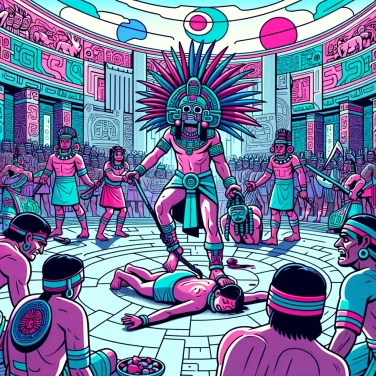The Aztecs sacrificed captives during religious ceremonies because they believed that these human offerings were necessary to feed the gods and maintain cosmic order, thus ensuring the survival of their civilization.

Among the Aztecs, human sacrifice was not just a bizarre or cruel trend; it played a downright vital role in their worldview. They believed that the gods had sacrificed themselves to create the universe and that the sun risked extinguishing each day if they did not provide blood in return. Human blood was perceived as essential energy, the nourishment that kept the cosmic balance alive. Without these regular offerings, the sun might cease its course, crops could die, and the world would plunge into chaos. So, for them, sacrificing humans — especially war captives — was a way to maintain harmony with the cosmos and to thank the gods for their own initial sacrifice. Not exactly a fun ceremony, but rather a sort of sacred imperative to ensure the survival of the entire community in their minds.
For the Aztecs, wars were sacred and allowed for the capture of enemies destined for religious ceremonies. The warriors did not necessarily aim to kill their opponent immediately: a living prisoner was much more valuable. These captives represented ideal offerings for the gods, their sacrifice ensuring cosmic balance and prosperity. The more prestigious or courageous enemies they captured in battle, the more it was considered honorable. Some conflicts were even specifically waged for this precise purpose, called flower wars, in order to continuously supply the ceremonies.
Aztec sacrifices were centered around rich symbolism, nourished by their belief that human blood was the vital fluid capable of nourishing the gods and ensuring cosmic balance. The heart was of paramount importance, seen as the seat of vital force, and it was generally this that was offered to the sun, so that it might continue its celestial journey each day. These ceremonies often included specific rites conducted by priests dressed in elaborate costumes representing various Aztec deities such as Huitzilopochtli (the warrior sun god) or Tlaloc (the rain god). The very sites of the sacrifices symbolically imitated the sacred mountains, earthly representations of the connection between heaven and humans. As for the captives, they symbolically embodied the defeated enemy forces, and their sacrifice affirmed the religious and military superiority of the Aztec people.
Aztec sacrifices also had a very concrete political dimension. Leaders used ceremonies to assert their power: to show their strength to other peoples and to their own subjects. It was a clear and straightforward way to say, "look how powerful our empire is." Sacrificing captives taken in war sent a strong message about the military and political dominance of the Aztecs over their neighbors. The more prisoners you offered, the higher your reputation rose in Aztec society. For leaders, displaying their power before the gods and their people helped to reinforce their political authority, but also to maintain a certain social control through fear and fascination.
The Aztecs believed that the sun itself was at risk of extinguishing if they did not regularly perform human sacrifices to fuel it with vital energy. They regarded these ceremonies as essential for the cosmic stability of the world.
The Mesoamerican ball game could sometimes end with the human sacrifice of certain players. However, under certain circumstances, being sacrificed was considered an honor and guaranteed a privileged place in the afterlife.
The Aztec priests observed the stars and used sophisticated calendars to determine the most appropriate dates for carrying out human sacrifices, believing that this would ensure better harmony between humans and gods.
Although they are notoriously famous for human sacrifices, the Aztecs also revered agriculture, art, and knowledge; cacao even held sacred value for them and was used as a medium of exchange.
Rituals could slightly vary depending on the circumstances and the deities being honored, but typically, they involved a strict ceremonial process where the victim was placed on a sacrificial stone at the top of a pyramid; a priest would then extract the still-beating heart as an offering to the gods. This act symbolized the vital offering intended to nourish and rejuvenate the deities.
According to Aztec beliefs, these sacrifices were not seen as cruel acts but rather as necessary, honorable, and even heroic actions to ensure the survival of their people. Their cultural and religious conceptions did not encompass human sacrifice according to our modern moral standards.
The majority of sacrifices consisted of war captives, regarded as prestige offerings. These prisoners symbolically represented the military power of the Aztecs and their control over neighboring peoples. Occasionally, volunteers or victims from the local population could also be sacrificed under certain particular circumstances.
Even though there were key moments in the Aztec year when sacrifices were particularly numerous (for example, during certain important religious festivals), these sacrificial rites could be practiced throughout the year, depending on the religious or political needs of the moment.
Sure! Here’s the translation: "Yes, indeed. Beyond the religious dimension, sacrifices had a very powerful political function. They allowed the Aztec leaders to assert their authority over neighboring populations, intimidate potential enemies, and establish their reputation as a dominant people in the region."
The Aztecs deeply believed that human sacrifices were essential for maintaining cosmic balance and the survival of the sun. By offering human blood to the gods, they thought they would ensure agricultural prosperity, avoid famine, and preserve the order of the universe.

No one has answered this quiz yet, be the first!' :-)
Question 1/5